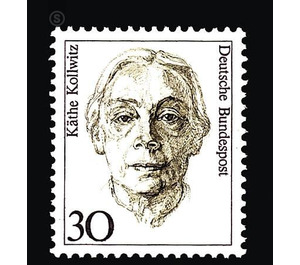Permanent series: Women of German History - Germany / Federal Republic of Germany 1991 - 30 Pfennig
Theme: Health & Human
| Country | Germany / Federal Republic of Germany |
| Issue Date | 1991 |
| Face Value | 30.00 |
| Color | brown white |
| Perforation | K 14 |
| Printing Type | 2-color Typography |
| Stamp Type | Postage stamp |
| Item Type | Stamp |
| Chronological Issue Number | 1361 |
| Chronological Chapter | GER-BRD |
| SID | 250108 |
| In 55 Wishlists | |
As a politically and socially engaged graphic artist Käthe Kollwitz occupies a unique position in the art of the late 19th and early 20th century. Personal concern and extraordinary social consciousness led them to the highest artistic expressiveness. Käthe Kollwitz was born on July 8, 1867 in Königsberg as the daughter of bricklayer Karl Schmidt and his wife Katharina. The parents discovered early on the artistic talent of their daughter and promoted them through extensive teaching. The study of painting in Berlin and Munich (1885-89) gave the young artist knowledge in the field of painterly realism and plein-air painting. Käthe Kollwitz always remained bound to the academic tradition of the late 19th century, which was oriented towards nature studies. But doubts about his own painterly talent in 1890/91 led to the first attempts in printmaking, which she exclusively turned to after the marriage with the physician Karl Kollwitz and her final move to Berlin in 1891. In this technique, she had finally found the adequate artistic expression of their artistic intentions. Käthe Kollwitz searched for the motives of her paintings in the world of workers right from the start. The artistic breakthrough came with the series of the "Weber Cycle", which she created in the years 1893-1998, inspired by Gerhart Hauptmann's play Die Weber. Here are already the central contents of their work realized - the social hardship and misery of the workers and their families as well as farewell and death as generally human phenomena. The seizure of power by Hitler brought about drastic changes for Käthe Kollwitz. Together with Heinrich Mann, she was forced in February 1933 to quit the Academy of Arts. 1936 was a general exhibition ban. But the work continued. Only the death of her husband in 1940 and her own health forced to rest. The events of the war caused Käthe Kollwitz to leave Berlin in 1943. On April 22, 1945, the artist died in her last refuge Moritzburg. (Text: Petra Dietz M.A., Kunsthistorisches Institut der Universität Bonn)


